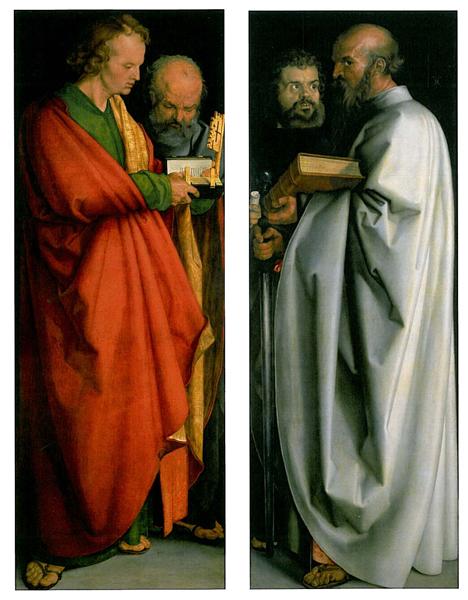
Although this pair of panels are usually known as “The Four Apostles”, in fact, the four men shown are, on the left, St John the Evangelist with St Peter behind him, and on the right, the Apostle St Paul with the Evangelist St Mark behind him. The figures are painted larger than life and the two in the foreground are monumental in character. This is clearly a painting about authority. In an earlier age, an artist might have shown the four evangelists as sources of the Christian faith, but this painting comes from Germany at the time of the Luther and these four figures are chosen because of their significance in that context. Dürer was native of Nuremberg, and he, like the city, had followed Luther. The two panels were presented by the artist to the city fathers as a gift, but they in return gave him an ample honorarium. On the left, a youthful St John reads from an open book. The open clasps suggest that the book has been locked. He is reading the first verse of his Gospel: “In the beginning was the Word.” Behind him an elderly St Peter holds a key, the symbol of his authority. He reads from the same page. To my eye, he looks like one who has lost his authority. On the right, a rather fierce looking, St Paul holds a book, which presumably symbolises his writings. He holds a sword, which of course was his attribute. Behind him, St Mark holds a scroll. There is a strong resemblance to Mantegna’s St Mark, which Dürer may have seen in Venice. These panels are a remarkably strong statement by Dürer of his Lutheran bias. One significant factor to bear in mind is how much the pattern of artistic patronage would have changed in these last years of Dürer’s career. In the newly Protestant cities of Europe, church patronage would have declined. The visual language of Christ and his saints was suspect. For decades, Dürer had enjoyed patronage within the context of the Catholic faith and devotion. Having returned to a newly Lutheran Nuremberg, perhaps this work was born of a concern to establish his “Lutheran” credentials. Although as Catholics, we cannot agree with the views on authority suggested in these panels, we can appreciate the ingenuity with which Dürer adapts the visual language of the Catholic faith to suit his ends.
The Catholic Chaplaincy serves the students and staff of the University of Edinburgh, Edinburgh Napier University and Queen Margaret University.
The Catholic Chaplaincy is also a parish of the Archdiocese of St Andrews and Edinburgh (the Parish of St Albert the Great) and all Catholic students and staff are automatically members of this parish.